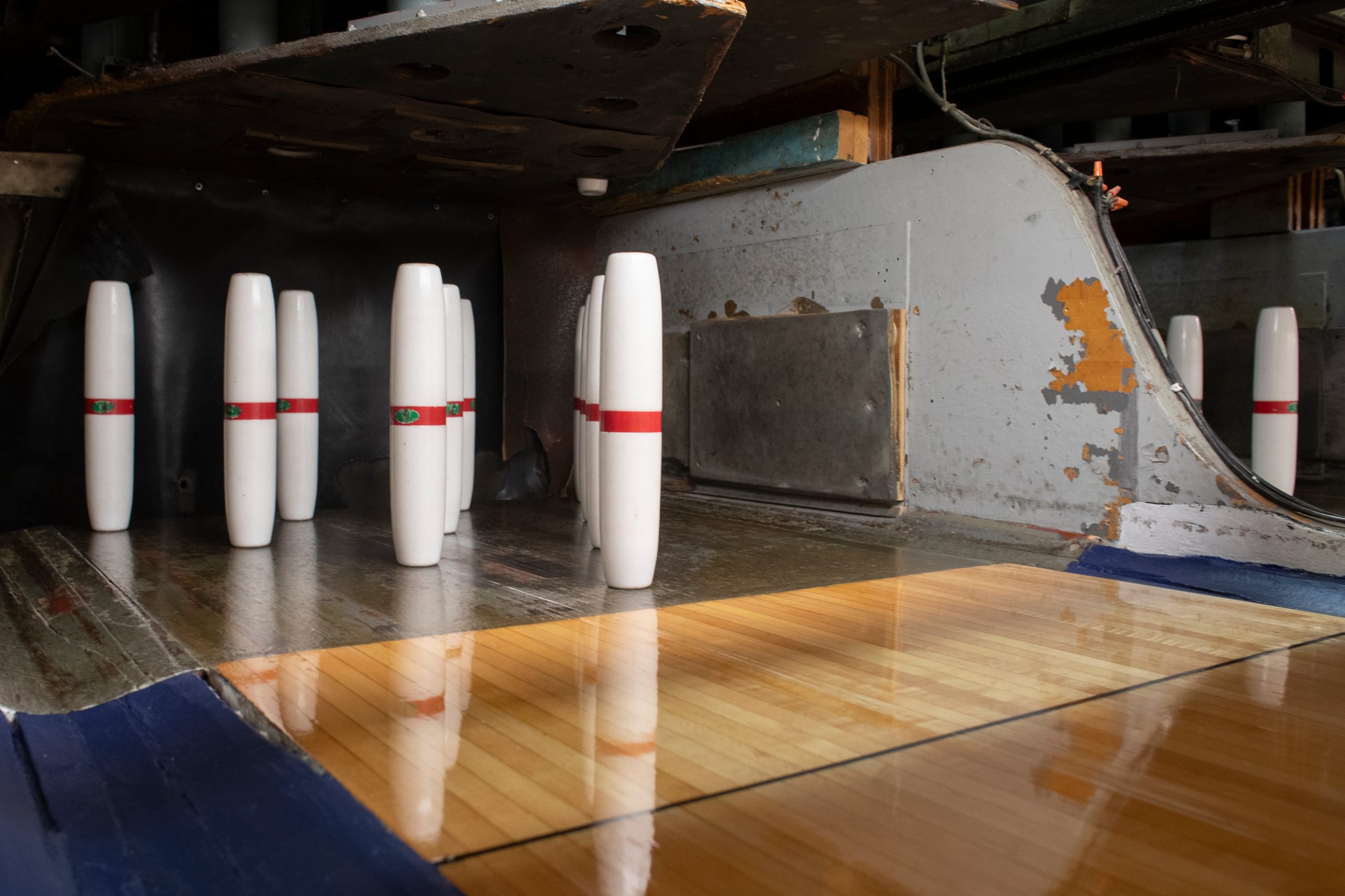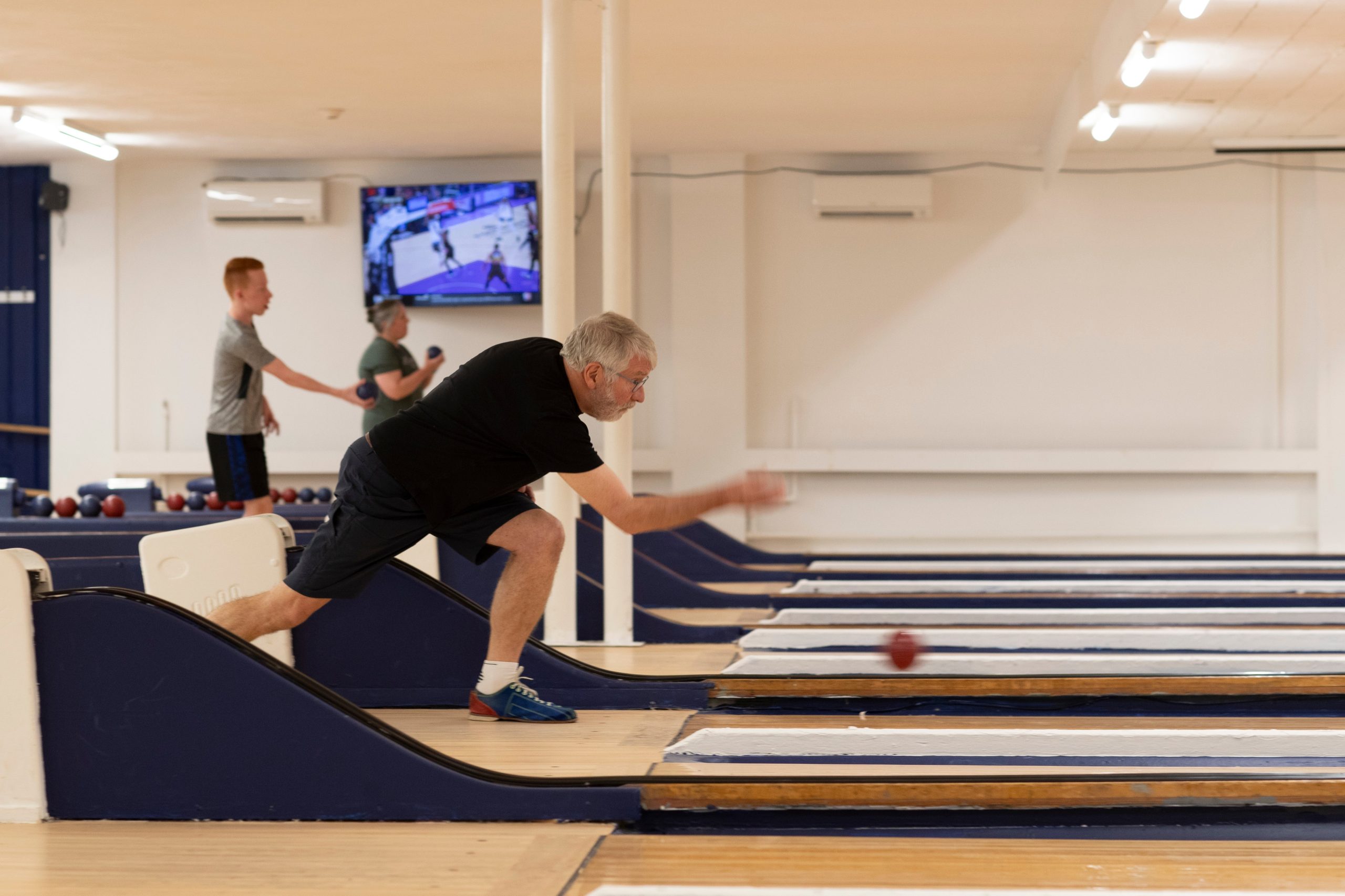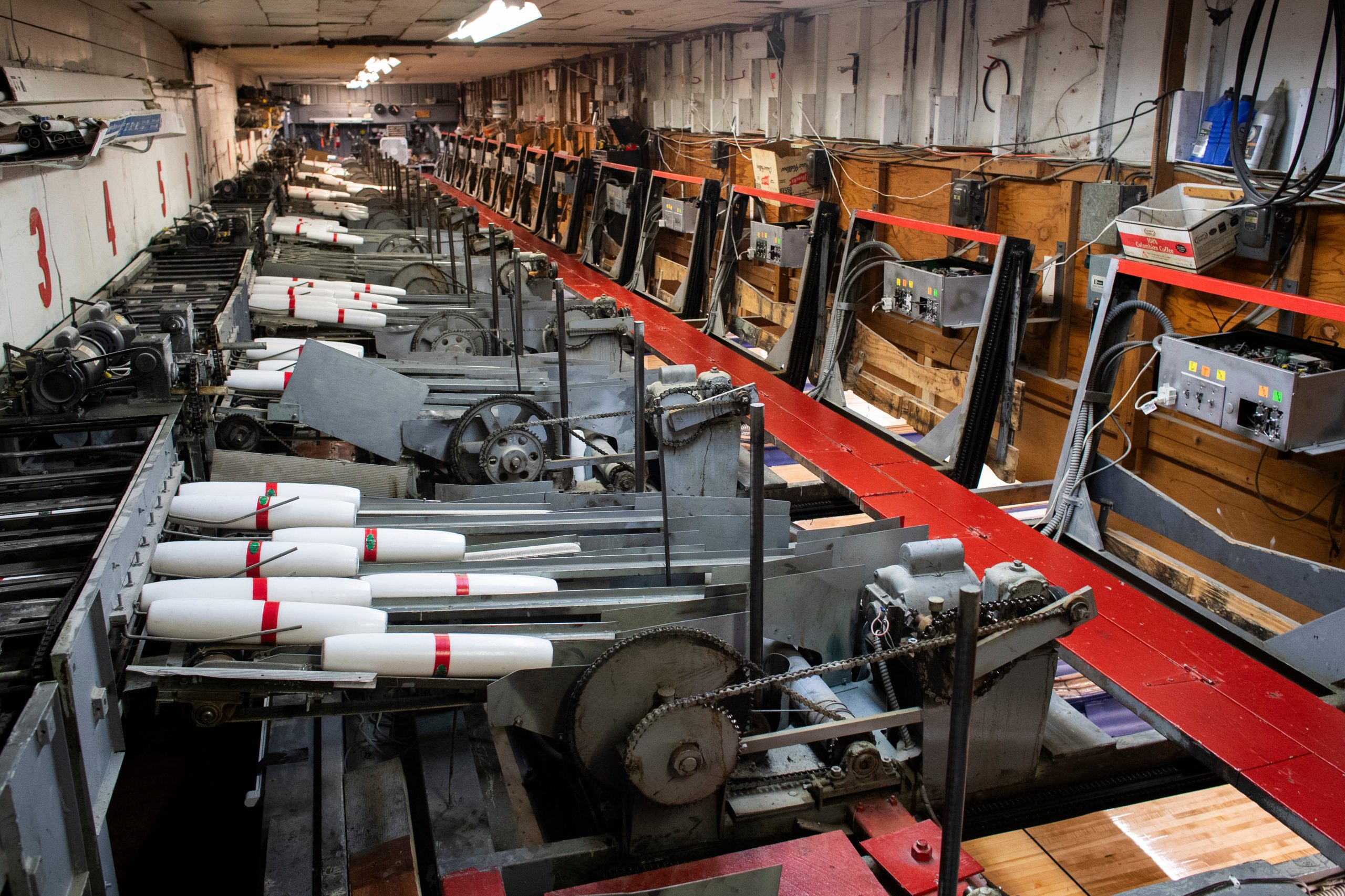While candlepin’s glory days are yet to return, there’s hope the Worcester-born pastime will live on for future generations.
Get Instant Access to This Article
Subscribe to Worcester Business Journal and get immediate access to all of our subscriber-only content and much more.
- Critical Central Massachusetts business news updated daily.
- Immediate access to all subscriber-only content on our website.
- Bi-weekly print or digital editions of our award-winning publication.
- Special bonus issues like the WBJ Book of Lists.
- Exclusive ticket prize draws for our in-person events.
Click here to purchase a paywall bypass link for this article.
If you want to go bowling in Central Massachusetts, you have a choice to make.
One option is ten-pin bowling. Simply referred to as “bowling” just about everywhere in the country, the sport is often referred to as “big-ball bowling” in New England.
Why the regional nickname for ten-pin? Because the other bowling option in the region is candlepin, of course.
Both games feature the same amount of pins and the same basic concept: Roll the ball down the lane, knocking over as many pins as possible. But differences in equipment and difficulty make candlepin uniquely distinct from its sibling sport.
In this age, with endless entertainment options and the proliferation of ten-pin, candlepin might have gone the way of the dodo bird.
However, it has proven resilient. After a few decades of mostly contracting, the sport seems to be on more solid footing in 2024. While candlepin’s glory days are yet to return, younger alley owners are making their way into the space, revitalizing older bowling centers and planning new ones, inspiring hope the Worcester-born pastime will live on for future generations.

A New England tradition
Candlepin was invented in 1880 by Justin White, the owner of a billiards and bowling parlor on Pearl Street in Worcester, according to the Worcester Historical Museum.
The game has since spread, albeit almost entirely confined to New England and Atlantic Canada. Over the decades, the pastime became a bit of a cultural staple in Massachusetts, regularly appearing on local television in the 1970s and 80s and leading to construction of dozens of alleys across the state.
The main difference between ten-pin and candlepin comes down to size and shape.
Candlepins come in at under three inches in diameter. The bowling balls are softball-sized and lack finger holes, coming in at around 2.5 pounds, less than half the weight of a youth-size ten-pin ball.

The physics of candlepin don’t allow for the typical curved shot seen in ten-pin to be effective. Instead, bowlers typically fire a straight shot hard at the front pin, hoping to hit it just slightly off-center.
In theory, the ball should deflect one way, taking care of the pins on one half of the frame, while the pin bounces off to the other side of the frame, cutting down the rest. In reality, it seems to rarely work that way; a shot looking and feeling perfect out of a bowler’s hand may result in just a few measly pins scattering to the floor.
But that’s part of the appeal, according to aficionados of the game.
“It’s harder. I think that’s what makes it a great game,” said Jim Shook, owner of Harvard Lanes in Harvard. “It does have the drawback in the sense that you’re not going to get as many strikes as you want, but that’s just how it is.”
Status quo
Even before the coronavirus pandemic disrupted business activity and changed consumer’s habits, there was talk of candlepin’s slow demise.
At least eight candlepin centers in Massachusetts have closed since 2000, including Ficco’s Bowladrome in Franklin, which closed in 2015 after 79 years of operation, and Colonial Bowling Center in Worcester, which closed in May 2020 after 60 years, leaving the city where candlepin was invented with no publicly available alleys.

Alley owners were reaching retirement age, and other centers, like Colonial, were sitting on land valued by developers.
However, in the past few years, the game has seemingly regained its footing, said Maria Angelotti, executive director of the International Candlepin Bowling Association.
“The state of candlepin right now is status quo, which is amazing when you consider how old it is and we’re coming out of a pandemic,” she said.
Based in Erving, the ICBA serves as the governing body for the sport, which involves things like managing the sport’s hall of fame and ensuring lanes at member bowling centers are compliant with regulations.
A key factor in preventing decline of the sport is the injection of some youthful enthusiasm, Angelotti said.
“I would say 10 or so years ago, 75% to 80% were older proprietors,” she said. “Now, you’ve probably got a 60% [older] to 40% [younger] split.”
Youthful energy
One younger face who brings a newer perspective to the game is Shook, the 39-year-old owner of Harvard Lanes.
Shook had spent most of his career working in the software space. But one day in the summer of 2023, Shook was bowling at what was then called 204 Lanes when he noticed a for-sale sign. With the support of a U.S. Small Business Administration loan and financing from Fitchburg-based Rollstone Bank & Trust, he purchased the 74-year old alley for $1 million in January.
“When the opportunity presented itself, I thought it would be a lot of fun,” Shook said. “The prior owner was looking to sell it as a commercial space, but I wanted to make sure it stayed a candlepin alley.”
Shook isn’t the only one saving centers with retiring owners from the wrecking ball. Joshua Sundberg, owner of Acton Bowladrome, purchased the 58-year-old Bayberry Bowling Center in Spencer for $800,000 in March.

When he took over Harvard Lanes, Shook revamped the space, refurbishing the lanes and applying a paint job, intending to make the space feel more inviting. Utilizing his software background, he’s considering creating a mobile app for the venue.
These types of upgrades are key to the sport’s future, said Angelotti.
“That is a must for anybody who's buying spent old centers to upgrade them,” she said, referencing amenities like automatic scoring, food and drink options, and modern arcade games, “People want to come after work. They can get a bite to eat, and they can have a drink. They can bring their kids if they want to send them to the game room.”
Despite his tech background, Shook has kept one old school feature: manual scoring.
“People really like that,” he said. “They say, ‘Oh, it’s good, because my kids have to learn math.’”
Big bowling
While the sport may be nearly impossible to truly master, the less-cumbersome playing equipment can make it easier for children, the elderly, and people with disabilities to play, said Shook.
But perhaps the biggest appeal of candlepin is its homegrown feel, particularly compared to its more nationally-popular sibling sport.
Candlepin centers in Central Massachusetts are all small businesses with local roots. This stands in contrast to ten-pin, which has seen private equity snatching up alleys.
Bowlero Corp., a Virginia-based firm operating ten-pin centers in locations including Shrewsbury and Auburn, operates over 326 centers across the country, appearing to be on a quest to establish control of the industry.

Longtime bowlers have accused the company of understaffing centers and cutting back on maintenance while increasing pricing, according to an article by The Lever, an investigative news site.
Efforts by large corporate entities to wedge their way into the candlepin scene have been rebuffed by existing owners, said Angelotti.
“About 10 to 12 years ago, a big corporation came in and started approaching all of the centers, and it fell flat,” she said. “Depending on property size, they were offering anywhere between $1 and $4 million to become part of this franchise, and not one person accepted it. So that tells you what the culture is of candlepin bowling. There is no room for that.”
Equipment issues
The lack of national popularity and the absence of big business does have some drawbacks, though, as replacement equipment can be tough to come by.
Steve Shomphe is the third-generation owner of Gold Crown Service in Auburn, a company which builds and services bowling lanes and related amenities.
Shomphe estimates about a third of his business is candlepin-related. These projects can be tricky.

“They’re really old machines. They don’t make parts for them anymore,” he said. “You can take an old machine and replace everything on it, but that’s a costly thing to do.”
When a lane closes, other owners scramble to acquire parts. Some people have used 3D printing technology to make parts no longer available, said Shompe.
“Everything was made out of wood before, so now if you replace it with plastic, it seems to be more durable,” he said.
Despite challenges, new candlepin lanes have been built in the last decade. American Flatbread, a restaurant chain where some locations have candlepin, opened a new facility in the Boston Landing development in Boston’s Brighton neighborhood in 2017. The company now intends to bring the sport back to Worcester as part of The Cove, a 173-unit, mixed-use building under construction on Green Street.
Work on the candlepin alleys at The Cove will begin in a few months, according to Thomas Keane, director of franchise development for the Flatbread Company.
"The American Flatbread and candlepin bowling alley is set to begin construction this fall," Keane said in an email to WBJ. "We are very excited about bringing candlepin back to Worcester where it was created. We believe it’s a great way to activate a community and we’re thrilled to be doing so in the Canal District.”
Chasing perfection
Candlepins connoisseurs are keen to bring up this fun fact: While tens of thousands of ten-pin games a year end with a score of 300, known as a perfect game, there has never been a documented perfect game in the 144-year history of candlepin.

In fact, no one’s even really come close: The best recorded score is 245, a mark hit by two bowlers: Ralph Semb of Erving in 1984 and Chris Sargent of Haverhill in 2011, according to Mass. Bowling Association records.
With at least 12 candlepin centers in operation in Central Massachusetts and an apparent return of candlepin to its hometown of Worcester, Angelotti feels there’s a chance someday, perfection will be achieved.
“The hope is still out there,” she said. “New Englanders are hearty. Someone, someday is going to make that perfect score.”
Eric Casey is a staff writer at Worcester Business Journal, who primarily covers the manufacturing and real estate industries.
EDITOR'S NOTE: This story has been updated to include a quote from Thomas Keane, director of franchise development for the Flatbread Company, regarding the company's new Worcester location. The chart accompanying this article has also been updated to include Bayberry Bowling Center in Spencer and Ryan Family Amusements in Millis.

